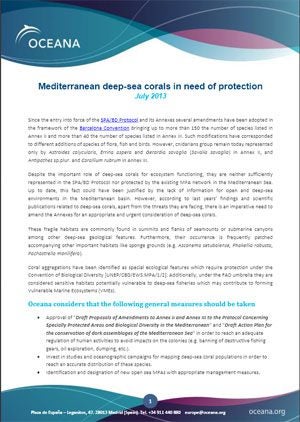Report | July 10, 2013
Mediterranean deep-sea corals in need of protection
Since the entry into force of the SPA/BD Protocol and its Annexes several amendments have been adopted in the framework of the Barcelona Convention bringing up to more than 150 the number of species listed in Annex II and more than 40 the number of species listed in Annex III. Such modifications have corresponded to different additions of species of flora, fish and birds. However, cnidarians group remain today represented only by Astroides calycularis, Errina aspera and Gerardia savaglia (Savalia savaglia) in Annex II, and Antipathes sp.plur. and Corallium rubrum in Annex III.
Despite the important role of deep-sea corals for ecosystem functioning, they are neither sufficiently represented in the SPA/BD Protocol nor protected by the existing MPA network in the Mediterranean Sea. Up to date, this fact could have been justified by the lack of information for open and deep-sea environments in the Mediterranean basin. However, according to last years’ findings and scientific publications related to deep-sea corals, apart from the threats they are facing, there is an imperative need to amend the Annexes for an appropriate and urgent consideration of deep-sea corals.
These fragile habitats are commonly found in summits and flanks of seamounts or submarine canyons among other deep-sea geological features. Furthermore, their occurrence is frequently patched accompanying other important habitats like sponge grounds (e.g.Asconema setubalense, Phakellia robusta, Pachastrella monilifera).
Coral aggregations have been identified as special ecological features which require protection under the Convention of Biological Diversity [UNEP/CBD/EWS.MPA/1/2]. Additionally, under the FAO umbrella they are considered sensitive habitats potentially vulnerable to deep-sea fisheries which may contribute to forming Vulnerable Marine Ecosystems (VMEs).


